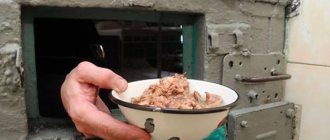People convicted of any serious or serious crimes are sent to correctional institutions represented by colonies, prisons or other similar organizations.
In these institutions, they are engaged in work activities and are also forced to follow a certain daily routine. They are deprived of freedom, entertainment and the opportunity to communicate with loved ones. Their stay in prison is paid for from the state budget.
Nowadays, food in various correctional institutions is considered quite tasty and nutritious, and the diet is determined individually by the administration of each prison. In this article we will look at what they feed in Russian prisons.
What do they eat in the colonies - diet
Each correctional organization has the right to independently develop a diet for prisoners, but for this purpose the provisions of various regulations adopted at the federal level are taken into account. Now convicts almost completely do not have any problems related to eating , but sometimes news appears in the media about theft or corrupt practices on the part of management or other prison employees.
Representatives of the Federal Antimonopoly Service regularly hold the heads of correctional institutions accountable for violations related to tendering.
For example, when holding tenders for the purchase of products, it is necessary to conclude an agreement only with the participant who offers quality products at the lowest price. But in fact, a contract is signed with another company, which provides the customer with a kickback, the size of which usually varies from 10 to 15% of the order size.
Important! Although the documents indicate some products, they include low-quality products that have low nutritional value or other negative characteristics.
The punishment for such violations is considered quite serious, so they are becoming less common. Before the adoption of the Order, prisoners experienced serious difficulties with nutrition, since the cheapest and even dangerous products were used. But now the food is considered high quality.
The diet includes meat, fish, fresh vegetables and fruits, cereals, milk and other similar products. Leaders of not only colony settlements or general regime, but also strict regime must follow the requirements of the law.
Breakfast
In the morning, prisoners are usually served porridge with milk, as well as boiled vegetables, sweet tea and bread. If pregnant or lactating women are kept in the colony, they are given a piece of butter . It is also issued to minors who are in a pre-trial detention center because they are suspected of committing a crime.
Dinner
It is considered the most satisfying and important meal of the day. Therefore, at lunch, prisoners receive not only the first course, but also the second. Initially, they eat soup, after which they are offered a side dish with vegetables or cold appetizers.
Prisoners additionally receive compote or jelly. Bread is provided with any dish. Snacks are often not available in pre-trial detention centers.
Dinner
In the evening, prisoners receive some kind of fish dish, which is supplemented with vegetables or porridge. They receive a small piece of bread and tea with sugar.
For minors or people in educational institutions, a piece of butter is provided.
How many were imprisoned under Stalin?
Stalin
was the greatest tyrant of all times.
Stalin
destroyed his people on an unimaginable scale - from 10 to 110 million people were thrown into camps, where they were shot or died in inhumane conditions.
Interesting materials:
How old was Kolchak? How many years do you get for causing bodily harm? How many years does secondary school last? How old is Anna Frolovtseva? How old is Lucas from Nst? How many years has Mikhail Krug been gone? How many years was Hurrem absent from the film? How many years did Evgeny Matveev live? How many years did the circle live? How old is the Russian alphabet?
Serving size per zone
The management of any correctional institution must monitor the correct diet of prisoners.
For this, a strictly defined volume of products is calculated, so the following rules are taken into account:
- first courses, presented in soups, are approximately 300 grams;
- if cold snacks are provided, they must weigh at least 60 grams;
- side dish weight – 200 grams;
- porridge – 250 grams;
- a piece of meat or fish should be 100 grams;
- sweet tea, jelly or other drinks are served in 100-gram glasses;
- Prisoners regularly receive fresh fruit, the weight of which varies from 150 to 200 grams.
Reference! According to the law, the diet of prisoners must be varied and of high quality, therefore it is significantly different from how prisoners ate literally 20 years ago, so people working in the kitchen must select the diet wisely so that dishes are not repeated and are prepared exclusively from safe products.
Example of a menu in the IR dining room
Menus in prisons are changed daily as kitchen staff are required to provide a varied diet.
The standard diet is three meals a day, consisting of the following dishes:
- breakfast - oatmeal milk porridge, a piece of bread and sweet tea;
- lunch - salad made from fresh cabbage and carrots, soup with meat broth and rice, boiled chicken with buckwheat and compote;
- dinner - pearl barley porridge with meat or fish, a piece of bread with tea.
If prisoners eat according to this menu on Monday, then on Tuesday the meals provided should change significantly. For example, semolina porridge is provided for breakfast, and pickle and goulash are provided for lunch. For dinner you can prepare dumplings, fish dishes or meat balls.
Fish cannot be used as a full-fledged alternative to meat, therefore meat products must be consumed by convicts every day . Accordingly, if fish soup is prepared for the first course, then the second course should be meat, but you can use not only standard meat, but also sausages, cutlets or canned food.
The photo shows an example of lunch in the colony:
Prison menu: eat to live
In these notes we will talk about what prisoners in Russian - primarily Moscow - prisons eat. In the pre-trial detention center, most prisoners eat so-called gruel - food provided free of charge by the administration. The gruel is prepared by convicted prisoners from the economic detachment. Nutrition standards are established by resolutions of executive authorities.
Food is brought three times a day: for breakfast, lunch and dinner, as in the wild. Breakfast includes porridge. It can be semolina, oatmeal, oatmeal or milk soup. Like the rest of the food, the porridge is not of the best quality: it is not sweet, but with the addition of sugar, oatmeal and oatmeal are quite edible. Breakfast also includes loose sugar and black bread (rarely white) baked in the pre-trial detention center - a relatively decent level. During the rest of the time, sugar and bread are not provided.
Lunch is the most high-calorie meal in a pre-trial detention center. For the first course you can get rassolnik, beetroot soup (something like borscht), cabbage soup, and pea soup. Almost always, these soups consist of only vegetables; they do not contain meat. Usually soups are not bad (for prisons), and pea soup can even be called tasty. Occasionally it happens that they contain bones and rotten potatoes; in general, the consistency is more like a puree.
The second one already relies on meat. It can be in the form of unattractive-looking cutlets - with cartilage inside, chicken gravy with pieces of boiled chicken, goulash, which is a heated stew. It is very rare to get large pieces of meat.
Rice, pasta, and barley, usually overcooked, are offered as a side dish. There is always plenty of side dish, so they leave it uneaten and simply throw it away. But there is too little meat for one adult. Occasionally there is a salad for lunch. This is a primitive mixture of cabbage and onions.
Dinner almost always consists of fish and potatoes, although the type varies greatly from day to day. Potatoes can be whole, cut into pieces or mashed, boiled or baked. The fish menu consists of pollock, herring, whiting. Again, it can be fried, salted, boiled, smoked. Both fish and potatoes are given in large quantities. As for quality, then - as with other food - its assessment depends on the person. People who are not accustomed to good food in the wild will quite like the quality of the food. Those who ate normally before being imprisoned are unlikely to be satisfied with the quality of prison food. Potatoes are peeled by machine, which is why skins are constantly caught, although in the second half of 2019 they began to peel potatoes more and more often by hand. The potatoes themselves are in a very cheap price range, sometimes there are tubers with rot. The fish is quite edible, although the so-called “grave” comes across. To understand what this is, imagine what they feed barn cats: a bunch of boiled fish, where there are much fewer fish than bones. Since the summer of 2019, they began to offer fish balls - a semi-finished product that is constantly undercooked.
In addition, for medical reasons, some prisoners are entitled to a so-called “diet” - additional food (in fact, this is usually a small piece of chicken). In SIZO-5 “Vodnik” you were also entitled to a carton of milk.
The drinks they made were very strong, disgusting-tasting tea. You can hardly drink it. I never remember anyone taking it, except in a punishment cell, and there, other than gruel, there was no other alternative. This tea was given for breakfast and dinner. For lunch there was either jelly or compote. Kissel is made by diluting dry powder. Its quality is constantly changing, and sometimes it is very tasty. It’s the same with compote: sometimes it consists of dried fruits, sometimes it’s an ordinary sweetish liquid.
The food in the punishment cell was the same in composition as in the permanent cells. But in the punishment cell, food was distributed at the very last place, which significantly affected the quality. Rotten potatoes, instead of meat, something like offal, instead of compote - a substance of unknown content. The question of the quality of food in the punishment cell was repeatedly raised by prisoners, because in the punishment cell, according to the rules, a prisoner cannot eat anything except gruel. Usually in a punishment cell hunger is satisfied with bread.
I described the food in pre-trial detention center No. 1 “Matrosskaya Tishina”, where I spent more than a year (autumn 2019). In addition, I was kept in pre-trial detention center-5 “Vodnik” for several weeks. In general, the food there was approximately the same - with the difference that the meat and side dish were placed in one bowl, and not separately: the prisoners sat and looked for meat in a huge portion of pearl barley or pasta. If you sleep while food is being distributed, and decide to eat later, you may be left without meat - with only one side dish.
At the same time, in quarantine, where they end up in a pre-trial detention center upon arrival, the diet differs for the worse. It was there that I saw dishes that I had never seen in the wild. For example, pink slurry with pieces of carrots in it is called borscht. Or porridge made from ground peas, which evokes unpleasant associations. The quarantine “grave” had a particularly large number of bones and little fish.
The main problem with the quality of food is that it is prepared by prisoners who have no incentive to do good work. They receive a minimum wage, from which funds are written off for their maintenance; that is, in essence, the economic team works in the position of slaves. Once upon a time, the prisoner Danila was the senior cook at Matroska. He approached his work with soul, tried to make high-quality dishes from the meager selection that he had at hand, and he did it very well. The time has come, and Danila applied for parole, hoping that the administration would give him a good reference for his efforts. But the administration’s plans did not include the prospect of losing such a valuable prisoner. As a result, a negative reference was sent to the court, and as a result, the quality of food in the pre-trial detention center deteriorated sharply.
Another reason for the dubious quality of gruel is the constant desire of the authorities to save on citizens. The cheapest products are purchased for prisoners. Thus, in pre-trial detention centers they constantly use cheap palm oil, adding it to all dishes. This causes heartburn attacks for many prisoners.
The prisoners are trying to “upgrade” the gruel. The simplest thing is to add various seasonings to it. You can mix pea soup with meat, instant noodles, and add vegetables. You can use bouillon cubes instead of pea soup.
As I mentioned, the quality of gruel in Moscow prisons is very relative. In Soviet times, prisoners were fed in a way that dogs were not fed; Until now, the food in colonies and provincial pre-trial detention centers has not gotten much better. In the words of one prisoner: “When you pass by the canteen in a colony, you can die from the smell that comes from it.” Those who have been through the colony say that compared to the food there, the diet in Moscow pre-trial detention centers is almost like dishes from a Michelin-starred restaurant. But if you compare this food with what they eat in the wild, or with what they feed prisoners in developed countries, then the gruel in Moscow pre-trial detention centers does not stand up to criticism.
Fortunately, the food in temporary detention centers (IVS) is much better. The reason is that temporary detention facilities are part of the system of the Ministry of Internal Affairs, and pre-trial detention centers are part of the structures of the Federal Penitentiary Service (FSIN). The financing of the Ministry of Internal Affairs is much more serious, and the supply of products is carried out on a contractual basis. For the first time I visited the temporary detention center on Petrovka; The food there is very similar to the food in the school cafeteria. Among standard products like buckwheat and pasta, there were crab sticks and seaweed. Some food could easily be eaten in freedom; for example, pea soup with smoked meats, pasta with chicken and tomato sauce. Although, as in the pre-trial detention center, there was a lot of side dish, but not enough meat. As a drink, they were given a tea bag without a label. By the way, in the temporary detention center there were no kettles in the cells, so you could drink tea only when an employee served boiling water.
The next time I was in the temporary detention center of the North-Eastern Administrative District of Moscow - on Ostashkovskaya Street. When I first got there, the food was even better than in the temporary detention center on Petrovka: food was brought from a cafe. The dishes were served to us in separate plastic containers. The food was tasty, but monotonous. For breakfast, as in the pre-trial detention center, there is porridge, for lunch there is mushroom or chicken soup, as well as a piece of chicken with a side dish (buckwheat or pasta). Sometimes they gave us simple salads like a vitamin salad, and for dinner we had another piece of chicken with a side dish. In addition, prisoners were given a bag of May tea (one bag per person three times a day), black and white bread, as well as a plastic cup, spoons, napkins, and refined sugar.
When I was brought to the same temporary detention center for the second time, six months later, the food became even better. The diet has become more varied: apparently, the supplier has changed. This was especially reflected in breakfasts, when they could provide porridge, cottage cheese, pies, and cheesecakes. A variety of dishes were also served for lunch and dinner: borscht, cabbage soup, navy-style pasta, high-quality cutlets, and once they even gave us a huge piece of pork that occupied almost the entire plastic container. This was the only time there was more meat than side dish. The quality of this food corresponded to what is supplied to the pre-trial detention center for a fee from the restaurant. I’ll tell you about this a little later, but I’ll note that in a temporary detention center of this level, food was provided free of charge.
Of particular note are dry rations, which are provided to prisoners when traveling to court. In theory, there are four different sets of dry rations, but in practice, prisoners are given only one set. Canned food must be heated - but, of course, no one will heat anything for anyone. True, many people keep these canned foods for themselves and heat them in the chamber. The dry ration includes meatballs in white sauce, rice porridge with beef, vegetable stew, mainly consisting of carrots, and liver pate. All these products are not of the best quality, but they are tastier than gruel. In addition, the packed lunch includes a large number of tasteless biscuits, a couple of tea bags, sugar, a plastic spoon, a glass, and napkins.
In addition to free food in MLS, you can order additional food for money. The assortment is quite diverse, and you can order from two suppliers. The menu includes soups, pizza, burgers, shawarma, kebabs, cakes, pies, etc. It is possible to order set lunches, which include a first course, a salad, a main course, and in some versions a drink (compote, hibiscus, fruit juice). In general, the quality of the food is quite good, we can say that it is at the level of a regular canteen. Although the supplier's website states that the food is delivered hot, in reality it naturally arrives cold. Microwave ovens are not allowed in cells, so prisoners make what is called a “steamer.” To do this, take two basins, pour water inside one, put a boiler, and then place a plastic container with food in the water (if necessary, place it on a stand made from another container). After which all this is covered with a second basin and the boiler is turned on.
There are other ways to satisfy your hunger in prison. Through deliveries, parcels, and the pre-trial detention center store, prisoners can receive various products. Most often they eat sandwiches, breakfast cereals with milk, cottage cheese, soups and instant noodles, cereals, cookies, and candies. Sometimes more complex dishes are prepared. So, usually in the cells they make a salad for dinner - most often from cucumbers, tomatoes, and herbs. It happens that they prepare soups and shawarma. Sometimes they even make a “prison cake.” The ingredients of the cake vary from case to case, although usually they are sweet crackers, condensed milk, and cookies.
Naturally, compared to Soviet times or compared to the provinces, prisoners in Moscow pre-trial detention centers eat quite well. But we must strive to ensure that the diet of prisoners is as similar as possible to the diet of people in the wild. Of course, some will say that the comparison is inadequate. But, according to the law, there are people in pre-trial detention centers who have not yet been found guilty; Accordingly, they do not serve a sentence, but are kept in custody so that they do not have the opportunity to obstruct the administration of justice. Well, good nutrition will not interfere with this important task.
Changes since 2016
Significant adjustments related to the nutrition of prisoners were adopted in 2016, when Order No. 44689 was signed.
The main changes that the convicts had to face include:
- food must be of high quality and varied, therefore it is forbidden to serve dishes prepared from the same products within one day;
- Previously, it was allowed to give prisoners rice soup for lunch and pilaf for dinner, but now this is a violation of legal requirements;
- first courses are prepared exclusively with meat broth, and not with water;
- kitchen workers are required to prepare main courses according to different recipes to ensure a varied diet;
- three meals a day are guaranteed, and the interval between meals should not exceed 7 hours;
- in educational colonies where minors are serving their sentences, five meals a day are provided;
- compote or jelly is regularly prepared, and prisoners in educational colonies receive coffee, cocoa and juice;
- It is prohibited to give prisoners iced tea or unheated food.
Inspections are regularly carried out to identify violations on the part of the administration of correctional institutions, and often even corruption schemes are identified that make it possible to obtain material benefits through the purchase of low-quality products.
As it was before
It’s worth starting with the fact that until 2016, in all, without exception, correctional colonies and prisons in Russia, the choice of diet for prisoners was, in fact, left to chance. It was before this time period that every second person (if not more) constantly complained about the daily food system, which was defined by a single slang concept “gruel”, which is the simplest possible stew (soup) without the presence of high-calorie foods in it. This circumstance has always led to difficult adaptation among persons who have just arrived at the place of serving their sentence, and often results in the occurrence of diseases, including psychological ones. In addition, the lack of high-calorie food led to a decrease in the activity of the contingent of correctional institutions, but on the contrary, sometimes led to mass riots and hunger strikes.
It should be noted that not all citizens of our country care about how and what the criminals eat, and even if their diet is truly terrible, this circumstance, due to the acts committed by the prisoners, does not cause pity. We can partly agree with this, since a place that is designed to ensure the infliction of appropriate punishment, and, therefore, as a result, to achieve repentance and prevent repeated violation of the law, a priori should not seem like a trip to a sanatorium. And the lack of adequate nutrition for centuries has been a fairly solid motivational factor for those who have already experienced all the “delights” of prison life.
Differences for different correctional institutions
There are several types of organizations in Russia that are designed for the temporary detention of criminals or delinquents. The management of these institutions uses different principles of catering.
Therefore, the following rules are taken into account:
- if the court imposes a sentence on the basis of which the criminal must serve his sentence in a penal colony, then before the trip he is equipped with certain food products, although the trip to the institution itself is paid directly by the convicted person;
- during the trip, you are given a dry ration, which includes bread and tea, canned meat or vegetables, and also meat porridge and stew;
- upon arrival, the prisoner receives three full meals a day, and it is varied and healthy, so meat dishes, cereals, stewed meat, pickles and even squash caviar are provided;
- prisoners can receive parcels from relatives, and it is allowed to transfer cheese, butter, sausages, fish, confectionery, milk and even chocolate, but it is important to properly package all food products, which are carefully examined by correctional officers.
If a relative wants to give a prisoner cheese or sausage, as well as fish, then only products that are in vacuum packaging are purchased, and only sterilized milk is selected.
In many prisons, illegal prisoners can buy various food products, sweets, honey or cigarettes. The sales are carried out by employees of the institution, who receive a certain material benefit from this process. When calling home or visiting relatives, prisoners often ask for certain products because they lack fresh fruit and confectionery.
Legislative aspects of this issue
In their work, MLS (places of deprivation of liberty) are guided by current legal acts. Food in prison is also not supplied just like that, but taking into account a compiled menu and a number of legislative provisions. Today, the following documents regulate issues related to the provision of food in prisons:
- Art. 99 Penal Code of the Russian Federation;
- order No. 44689 dated December 14, 2016;
- Federal Law-76 dated June 10, 2008.
Previously, these issues were regulated by a document drawn up and adopted during the Soviet era. Gradually, this legal act became outdated, and there was a need to amend it. Today the budget has also been increased, within the framework of which money is allocated to provide nutrition for men and women in custody.
Unfortunately, at the beginning of the 2000s, the problem of providing food to prisons and colonies was very acute. The only help prisoners received were purchases in the “prison store,” common funds, and food sent from home by loved ones. Currently, there are no such difficulties, and the new catering regulations will reduce overall costs.










